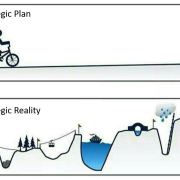We need to stop confusing productivity with business performance
I have a love-hate relationship with ‘Productivity’. On the one hand, productivity, in the right circumstances, is an essential part of being an efficient business and delivering value to your customers. Its measurement is also invaluable in assessing the effectiveness of your efforts to improve. However, far too many businesses believe that they can increase productivity simply by focusing on productivity – manipulating the inputs and outputs of the productivity metric.
Productivity is a result of the way that a business operates – the result of the way that its people, business processes, different functional units and suppliers come together to meet the needs and wants of its customers. Productivity improvements can only come from actions and activities that improve the way your business operates.
Productivity is a simple concept that most businesses misunderstand
Productivity is used to describe an ever-increasing range of performance. Many organisations associate it with the cost of labour – wages. Some productivity think tanks get caught up in the efficiency and effectiveness of different funding mechanisms. Some productivity specialists develop extremely complex and multi-dimensional algorithms that try to capture every aspect of a business’s productivity in a single metric.
These excursions move us away from what productivity really is. Its formal definition is pretty simple:
Productivity is the unit output per a given unit of input.
Or as a mathematical expression:

It is hard on the surface to argue with the premise that the business capable of either generating a given output while requiring less input or generating greater output for the same amount of input will have a competitive advantage. Problems start to present themselves when you dig just a bit deeper and question these three simple terms:
- What outputs best define business value?
- Which inputs are critical to business performance?
- How do I go about measuring this combination of inputs and outputs so that one directly correlates to the other?
This challenge in identifying and reliably measuring productivity when combined with the oft quoted belief that productivity can drive business performance leads to a number of misconceptions and missteps:
- The sum of the productivity parts equal a productive whole – this is rarely the case and instead tends to create a series of trade-offs that maximise metrics in individual areas at the expense of the whole.
- Focussing on either minimising the inputs or maximising the outputs rather than optimising the combination of the two. Particularly pronounced when combined with problem 1 above.
- Trying to hit a productivity target every day – productivity is best used as a trending tool to understand if performance is improving or declining, if it is highly variable or relatively steady.
- Trying to fit all effort or business outcomes within a productivity analysis to the detriment of innovative thinking.
- Basing analysis on easy to measure inputs and outputs (for example capital and labour hours) – this can create a false picture of where improvement efforts should be focused.
These productivity misconceptions can cause organisations to lose sight of the things that actually drive business performance
Any business could be forgiven for obsessing over productivity. Business guru Peter Drucker even wrote:
“Without productivity objectives, a business does not have direction. Without productivity measurement, a business does not have control.”
Although I respect Drucker’s observations on business immensely, in this case I think he got it wrong. Productivity objectives are only one element of a business’s direction – a highly-productive business that doesn’t produce products or services to attract and retain customers is going nowhere. Appropriately defined productivity measurements are valuable feedback on business performance but they have no role in controlling business performance. Productivity is like the dashboard in your car – the speedometer, tachometer and engine gauges – control comes from the way you use the foot pedals and steering wheel.
An unbalanced focus on productivity can cause a business to lose sight of the fact that their people, workplace culture, business strategy and the continuous improvement framework are the real points of control – the brake and accelerator of business performance. It can result in a business that reacts to the numbers rather than using the data as one part of a feedback mechanism on their improvement and adaptation activities.
Make productivity a powerful part of your business performance platform
Productivity is an important element of a thriving business. However, it is but one plank on the platform of business performance. Productivity analysis is much more powerful when used in conjunction with other approaches to improving business performance. Here are five ways to really get productive with your productivity:
1. Understand the efficacy of your improvement activities.
Use productivity as only one of several performance metrics that you use to assess the effectiveness of continuous improvement and business changes. Consider also: customer reaction including sales trends; responsiveness factors like speed to market; quality measures such as defect reduction, rework or returns when making assessments about your improvement activities.
2. Identify the underlying cause.
Don’t assume that the actual productivity measurement provides the source of any issues. They are often surrogate indicators of the real issues that need to be addressed.
Colleagues from Strategic Project Solutions in San Francisco tell a story about a call they got from a client in the UK asking for help with a labour productivity problem that could cost them millions of pounds in over-runs if not rectified. The client suggested time and motion studies to explore the reason for their labour problem but SPS took a holistic view of the situation to identify the underlying cause. They found the productivity issue stemmed from unreliable material supply – which in turn came from inaccurate and unreliable information from the client about the upcoming material requirements. The client team mistakenly believed that the problem sat with their workforce because the productivity they were measuring was couched in output per labour hour.
3. Make the information relevant to the people doing the work.
It is rare that productivity is a useful means of guiding the improvement activity of your business or teams. They rarely have direct control over the combination of inputs and outputs that make meaningful productivity measures. What they do control is the activities they do every day and how they interact as a team. Give your people metrics that are related to the work they are doing so they can see where improvements could be made. Better still, develop measurements and associated analyses that give them useful information on what specific things they might do to improve.
4. Create an environment that supports productivity.
Productivity is best used as an assessment of the working environment – and it’s optimising the interplay of the various influences where exceptional business results are generated. Create cross-functional teams to shape the environment in a way that allows teams to perform at their very best. Be clear about what the business’ performance expectations are and which improvement opportunities are the highest priorities, then support them in making positive change.
On a recent project for a client, we were exploring how productivity measurements might be used as a KPI for continuous improvement. One of the proposed metrics was design cost per dollar of direct product cost (for some reason this industry likes to turn the productivity equation upside down). Because they had assumed that design is an overhead (or indirect cost) their belief was that reducing design cost input is a positive productivity result. I was able to help the team understand that an environment where product costs could be reduced without requiring any additional design engineering was actually a very positive business result – and would be poorly represented by their proposed KPI.
5. You can’t measure all productivity so don’t try.
Productivity measurement doesn’t have a place in every part of your business. The performance of today’s knowledge worker cannot be assessed by the simple output over input equation. There are far too many inputs in their work, the value of each of those inputs are far too varied and the linkage between a set of inputs and the resulting outputs are too disconnected.
It is far more important to establish teams that are creatively engaged in their work and motivated to deliver overall business value than it is to ensure that every worker is maximising the output during every moment of their business day. Time spent nurturing both internal and customer relationships can often drive greater business returns than the number of design drawings or lines of computer code written. Effort spent exploring concepts and brainstorming ideas can ensure that production activities don’t end up in iterative loops that take the entire team back to the drawing board.
When Google was looking to create the ultimate team environment, they created ‘Project Aristotle’ – a multi-faceted analysis on how to get the most out of a team. What they found was that business success lay far from the group of ultra-productive, algorithm-driven technological whiz kids that you would expect of Google. Instead, the key elements of the best teams lived in the hard-to-measure world of culture and group dynamics; specifically, how “members listen to one another and show sensitivity to feelings and needs”. In his book Smarter Faster Better: The Secrets of Productivity in Life and Business, Charles Duhigg provided the following commentary on these findings:
”Project Aristotle is a reminder that when companies try to optimise everything, it’s sometimes easy to forget that success is often built on experiences – like emotional interactions and complicated conversations and discussions of who we want to be and how our teammates make us feel – that can’t really be optimised.”
Questions for consideration
As you think about the role that productivity and the measurement of productivity plays in your business, ask yourself these questions:
- How could I use productivity measurement to give me better feedback on the improvement activities that my teams are undertaking?
- Where do we focus on productivity results that may not be serving our business performance as a whole?
- Are their areas where an emphasis on productivity may not be creating the space for creativity, innovation and forward thinking?
Never miss a post – sign up for my newsletter here








You have made some really good points there. I checked on the internet for additional information about the issue and found most people will go along with your views on this web site.